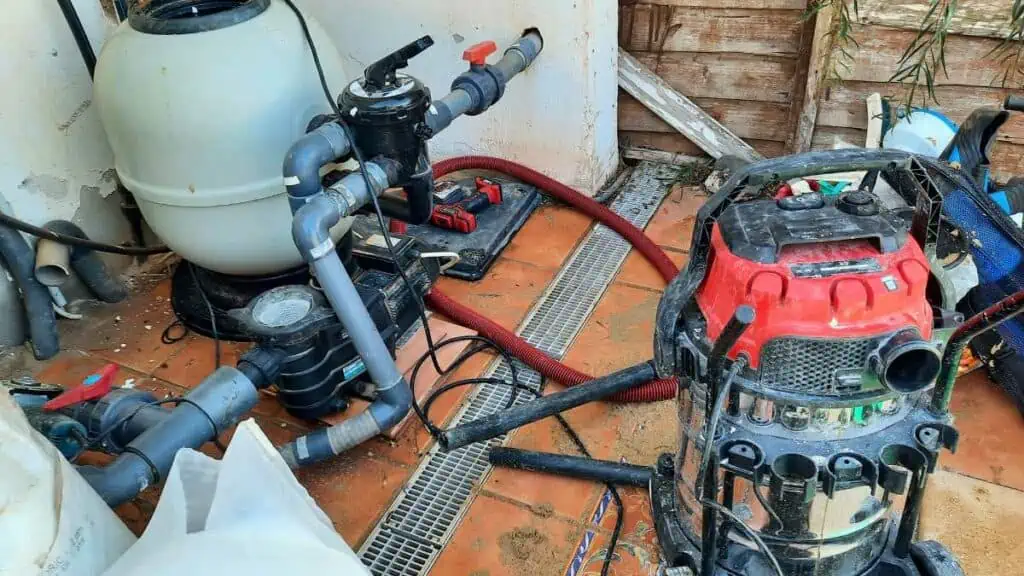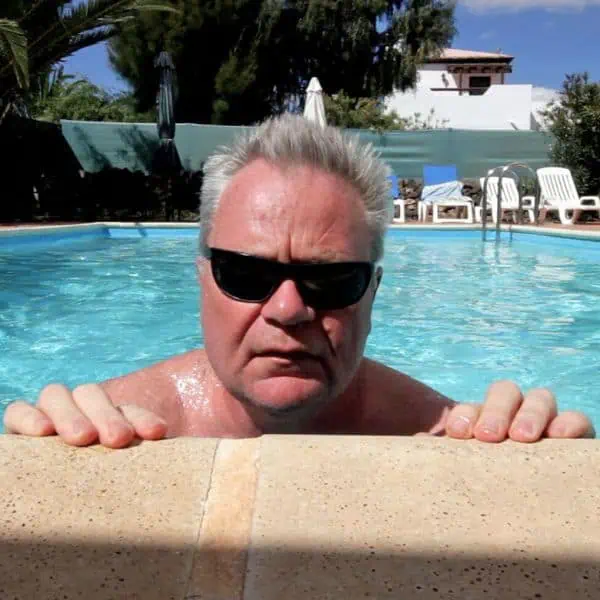Sand in pool filters should normally be changed every five to six years. It is only effective as long as the sand remains rough and coarse.
Over time these particles rub against each other, the filter, and dirt particles, which makes them smooth and inefficient. Five years is generally a good estimate of when to change sand in pool filter but you can use the same sand for longer if you don’t use your pool a lot.
This article will explain why you should replace your pool filter sand according to the given timeline. It will also go over a few topics related to this process including the risks that come with it and a step-by-step guide for how you can do it safely.


Why change the sand in a filter?
Pool filters are installed in every swimming pool setup to remove dirt, bacteria, etc. They contain several components, the most important among them is the filter media which is most frequently sand but can also be DE (Diatomaceous earth) or a paper filter cartridge.
This filter media grabs and then traps unwanted particles that may contaminate your pool. It is able to do so because its surface is rough and coarse.
This property comes about because of the sand in it. There are a couple of different types that are used including glass sand, silica sand, and zeolite sand.
Irrespective of what type has been used in your pool’s filter, the sand works because its surface is rough. They are ground to about .45 to .55 in diameter which is coarse enough to trap debris but fine enough to allow water to pass through.
As time goes on, this sand begins losing this essential property. The particles rub against each other, dirt, and the filter itself which then smoothes the sand particles’ surface. The sand particles are also ground down and made smaller.
Once this happens, the sand filter media doesn’t have the coarseness necessary to trap dirt and bacteria. The sand particles become too small to trap the contaminants and eventually they flow through the filter and go into your pool along with the water.
This dirties the water body and can be harmful to your health. So you have to change out the sand before it reaches this point.
Pool sand filter diagram
How to change sand in pool filter

There are two types of sand filters: the ones that come with a drain plug and those that don’t. So there are two ways of changing sand in pool filter.
Filter with a drain plug
The first one involves filters that have a plug at the bottom. It allows sand to flow out. This drain plug is usually quite big and sand can come out from it once you open it.
You can use a garden hose to thoroughly wash out the sand from the tank.
Filter without a drain plug
If you have a single-piece sand filter tank that doesn’t have the type of drain plug that allows sand to drain out, you will have to dig out the sand yourself.
Now follow this process:
1. Turn off the power to your filtration system
2. Remove the multiport valve
Only do this if you have a top-mounted multi-port valve. You’ll need to cut the PVC couplings and connections to loosen the collar of the multiport valve. Make sure that you leave some portion of the clear pipe so it’s easy to reconnect it once you’re done.
3. Use a flashlight to see inside the filter
Shine a flashlight to see inside your filter. You may see a layer of contaminants like grease and hair at the top of the sand bed. If you do then use a cloth or glove to remove it.
4. Move the standpipe to a side
Be careful while doing so and make sure you don’t break the pipe. Take a look at the top of the sand and the walls inside of the vessel. This is the sand you have to remove.
If you damage the standpipe or the laterals then you will find your pool filter blowing out sand.
5. If you remove part of the sand
Most times, you don’t need to replace all of the sand in sand filters. You can get away with replacing some of it.
If you choose to do this, all you have to do is take out the top layer of sand. The particles underneath are normally clean and good to go.
So just replace what you took out with new sand.
6. If you remove all of the sand
If you decide to empty all of the sand and replace it, you will have to follow a slightly more complicated process. First, you need to take out as much of the sand as you can with a trowel or bucket.
You can also use a good wet/dry shop vac to speed this up.
Once you get to the lateral assembly, fold the lateral arms upwards but also check carefully that you don’t have any broken laterals. If you do they will have to be replaced.
Take the component out and wash it. Both these arms have small slits in them that allow water to pass through. You’ll be able to see them easily. Once you’re done, look at the standpipe. Inspect it carefully to check for cracks or breaks.
Rinse out the remaining sand and then you can fill the tank with new sand. All filters have a plate on the outside that specifies how much and the type of sand you should use. Always use whichever type is recommended by the manufacturer as they know what suits their product the best.

How often should you change sand in pool filter
Generally, you should change the sand in your pool’s filter every five years. However, depending on how much you use the pool and the extent to which you take care of its maintenance (such as proper backwashing), this time period can increase or decrease.
If your pool isn’t properly maintained and chemically imbalanced, the sand filter will need to work extra long. So the frequency of changing sand media will increase.
However, if you don’t use your pool a lot, manage it well, and ensure it is chemically balanced, you can use sand for up to 7 years.
What kind of sand is used in pool filters

It’s inevitable that you will have to change the sand in your pool’s filter at some point. So we’re including this section to recommend our preferred sand filter media.
Firstly, what is pool filter sand? Well, it isn’t just any old regular sand such as builder’s sand, children’s play sand or something you can go and pick up at the beach. It is sand that has particular properties that are suitable
Pool filter sand specifications
Silica sand for pool filter
While there are a lot of different types of sand used in sand filters, the best one is silica sand. The most common type is #20 silica sand. It is made from ground quartz that has jagged edges. They are great at trapping particulates from passing water.
While you can use the other types of sand we mentioned before as well, they’re more expensive. Moreover, you might come across ‘recycled’ sand in pool stores. This kind of filter media may be used but you need to check it thoroughly to make sure it isn’t old and still coarse enough to get the job done.
FairmountSantrol AquaQuartz-50 Pool Filter 20-Grade Silica Sand
Glass sand for pool filter
Silica sand has a bad environmental impact but it is the best option available. If you are willing to spend more money, you can invest in glass sand. It has a lower environmental impact since it is made with recycled glass.
Also, glass sand can capture particles that are as small as two microns. That is one-millionth of a meter. The glass particles are sized differently so you don’t have to worry about channeling. Channeling is when pool water separates the sand and creates a smooth path for it to flow through.
This happens with sand once in a while. But it won’t ever happen with glass.
Another great benefit of using glass sand is that it can capture magnesium and iron particles. This is because of its negative charge.
LODOICEA 100% Recycled Swimming Pool Filter Media Glass
Zeolite pool filter sand
Zeolite sand is made with volcanic rock minerals. It has a greater surface area to volume ratio compared to normal silica sand because it has a honeycomb shape. This allows it to trap chloramines through a process called molecular sieving.
These byproducts of chlorine get trapped in the zeolite sand indefinitely. So you can avoid having to shock your pool regularly.
The best sand for your pool filter
While having in-depth knowledge of sand types is important as it allows you to compare the different types, it comes second in importance to your filter’s manufacturer’s recommendations.
Even if you feel like zeolite sand may be better for your pool, you should use silica #20 if that is what the manufacturers who made your sand filter say you should use.
Pool filter balls
In recent years an alternative to pool filter sand has been developed. These are fiber balls that are put into pool filters in place of filter sand but which act in the same way. They are more eco-friendly than sand.
I haven’t used them myself but I have read some good reports about them. I will probably try them the next time my filter sand needs changing.
These Rx Clear Blue Luster Filter Balls are popular on Amazon.
When to change sand in pool filter
In case your pool filter stops working correctly, you should take a look at a couple of other things before rushing to replace the sand. It is a long and complicated process that shouldn’t be started unnecessarily. Sometimes the problem is just that your filter system can’t cope with the force of your pool pump.
After a thorough inspection, if you find that your pool water is chemically balanced and there isn’t an issue with the mechanical part of your pool filter, you should look at the sand. When everything else is working fine but your pool’s water is still cloudy, the sand is probably causing the issue.
The best time to do this is before the season starts. Prices at pool stores are usually lower at this point so you’ll save money.
How much pool filter sand do I need?
The amount of sand you will need varies depending on the make and filter size.
The amount can be as low as 30 lbs for a small Game Sandpro filter to as much as 500lbs for a 30 inch Hayward Sand Master.
Most will have a label on the outside telling you the sand capacity.
Changing the sand in your filter can cost up to $500 for a large filter. You don’t need to hire someone to do the job as the process is fairly straightforward. At the same time, it is a cumbersome process and can require a lot of work.
So you should avoid going through the entire thing when it is not necessary to change all of the sand.
If you see signs of clumping or channeling when you open up your filter, you should take out a few inches of sand from the top and replace it with new sand.
Expert’s Tip: You don’t always have to change out all of the sand in your filter. Sometimes replacing the top layer is more than enough.
Frequently asked questions
Can I use old sand for my pool filter?
No, you can’t use old sand in a sand filter. Doing so will contaminate your pool and damage your filtration system. You’ll end up needing professional maintenance to fix it which will cost way more than a few packs of new sand.
When is the best time to inspect my sand filter?
You can usually tell when there is something wrong with your filter. Once you know how the machine acts and sounds normally, you can interpret any change in its pressure, sound or rhythm as a sign that there is a problem.
Do I have to change out all the sand?
No, you don’t have to change all the sand. If your filter stops working because of clumping and channeling, you just need to take out the top layer. However, if you’ve been using the sand in the filter for over five years and it seems to be worn out, you’ll have to replace it entirely.
What to do with old pool filter sand
If it is sand you are replacing (not glass) then you can use this in the garden to provide drainage in heavy soils or save it for the winter to sprinkle in icy paths or drives.
Final thoughts
As a general rule of thumb, changing sand in pool filter should take place every five to six years. You may need to inspect your filter sooner if you use your pool a lot, if you haven’t been paying attention to the pool chemicals treatment, or if regular maintenance including backwashing has been skipped.
At times, your filter may be acting up due to clumping and channeling. If this is the case, replacing the top layer of sand and mixing in an additive will fix the issue and prevent it from happening again.
Once your sand media has been used thoroughly and it is time to change it out completely, the first thing you need to do is get more sand. Purchase the type recommended by your machine’s manufacturer.
Then depending on whether or not your filter has a drain plug, follow the steps detailed above to change the swimming pool filter sand. Try to do this before the season starts so you don’t have to close off the pool during the peak swimming season.
If you ensure your pool’s proper maintenance, you can use your sand media for a few more years, perhaps up to seven or eight years.
Also read: The pool filter settings explained










Leave a Reply